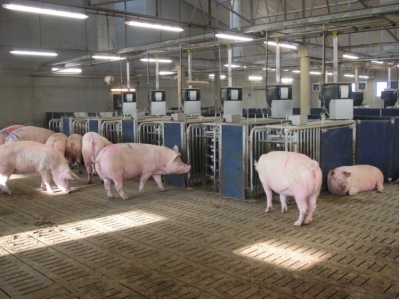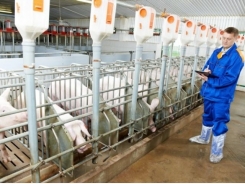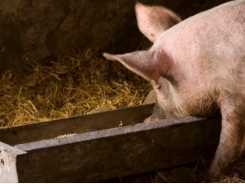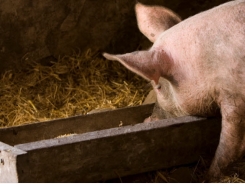Feed size, makeup may make pig manure less explosive

Manure accumulation in storage pits can be a fire or explosion hazards, but smaller feed particles and more digestible fiber may lower risks.
Scientists at Iowa State University started researching foam accumulation in swine manure storage facilities after a series of fires and explosions at swine barns in the Midwest, said corresponding researcher Daniel Andersen, assistant professor of manure management and water quality.
“There were some occasional reports of foam on the surface of manure, but it was usually as a result of an acid treatment to the manure, or lots of agitation, and even these were relatively uncommon,” he told FeedNavigator. “However, around 2010 we started getting calls from swine farmers stating that they had 1-4 feet
That concern deepened when researchers discovered that the foam was storing methane, he said. “Things like sparks from heaters or welding slag could start the foam on fire,” he added.
Foam is now much more common than it once was, said Andersen.
“We've seen changes in swine diets that have led to the use of higher fiber ingredients and also numerous water conservation measures implemented at many barns which have resulted in thicker, more organic matter rich manures,” he said. “The history of foaming in anaerobic digestion systems tends to suggest that higher organic loading rates to the digester (the manure storage pit in this case) tend to increase the risk of foaming.”
In the research, the team examined the interaction of fiber content, manure inoculation and diet grind size with manure properties related to foaming, said researchers.
“Factors that reduced digestibility (bigger grind size, more neutral detergent fiber) resulted in increased foaming properties,” they said.
Experiment details
Two sets of 24 pigs were given one of six diets for 49 days, said researchers. The diets included one made of corn and soybean meal (C-SBM), one with corn and dried distiller grains with solubles (C-DDGS) or one with corn and soybean hulls (C-SH) – all diets were ground to either fine (374 μm) or course (631 μm) particle size.
Diets had different lipid and fiber contents, they said. The C-SH diet had the largest amount of neutral detergent fiber and the C-SBM diet had the least.
Manure tanks were agitated and samples taken at the end of the trials, they said. “Manure samples were assayed for total solids, volatile solids, biochemical methane production potential, methane production rate, surface tension, particle size, and foaming capacity and stability,” they added.
A second trial was run where the manure was treated with an inoculant from the manure of the first group getting the same diet, said Andersen.
“We inoculated the manure for the second trial as the methanogens that make the biogas are notoriously slow growing, so we were trying to use the old manure to give them a head start - that is to enrich our manure in these methanogens,” he said.
Results and treatments
Less digestible feed, led to more solids in the manure, more foam and higher potential for biological activity, said the researchers. Foaming manures tend to have more solids.
Pigs getting course ground feed produced manure with more solid content, they said. And, when finely ground, high-fiber diets tended to have more solids.
“Manure from pigs fed the fin C–SH and CSBM diets (18% and 23% reduction respectively), leading to a significant grind × fiber source interaction,” they said. “This would suggest finer grinding had a larger impact on DDGS than on soybean hulls, potentially indicating that finer grinding is more beneficial in improving hemicellulose digestion than cellulose digestion due to the solubility of these particular fibers.”
“The challenge is the finer grind also lets them utilize more fiber rich ingredients in the diet as it is better digested in the pig,” said Andersen. “So what we are currently ending up with is grind finer to improve digestibility, but then replace some of these ingredients with other things that are cheaper and a bit less digestible. So just grinding finer alone won't solve the issue if as a result we substitute less digestible ingredients.”
A goal for reducing flammable or explosive tendencies with manure would be to decrease foam and have it be unstable, he said. “If the bubbles break apart it will release the methane gas continuously rather than accumulating a fuel source for a potential barn fire or explosion,” he said.
A potential treatment to mitigate foam would be to break down proteins or other factors making foam more stable, he said.
The group is currently examining microbes associated with different feed ingredients and how they link to microbial populations in foaming manure, said Andersen.
Related news
Tools

Phối trộn thức ăn chăn nuôi

Pha dung dịch thủy canh

Định mức cho tôm ăn

Phối trộn phân bón NPK

Xác định tỷ lệ tôm sống

Chuyển đổi đơn vị phân bón

Xác định công suất sục khí

Chuyển đổi đơn vị tôm

Tính diện tích nhà kính

Tính thể tích ao




 Essential oils, diet may boost piglet growth, gut…
Essential oils, diet may boost piglet growth, gut…  Sugar beets may offer feed alternative, boost young…
Sugar beets may offer feed alternative, boost young…